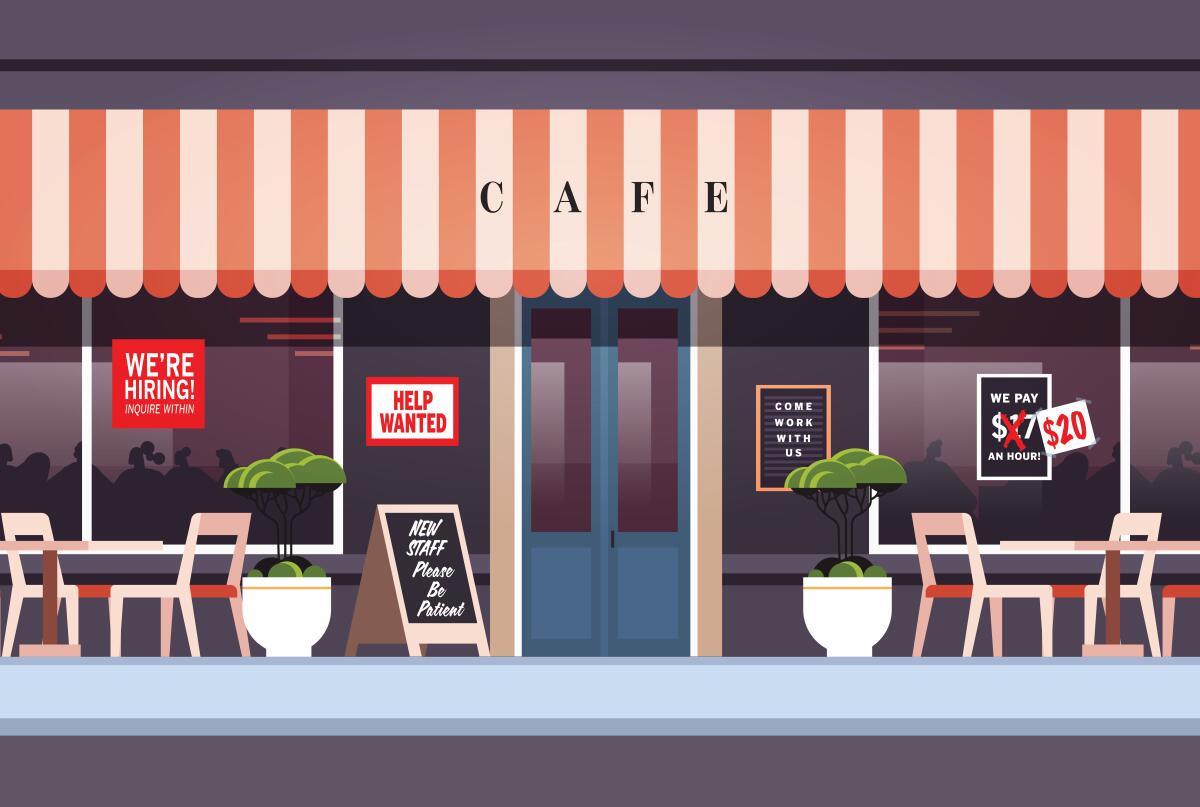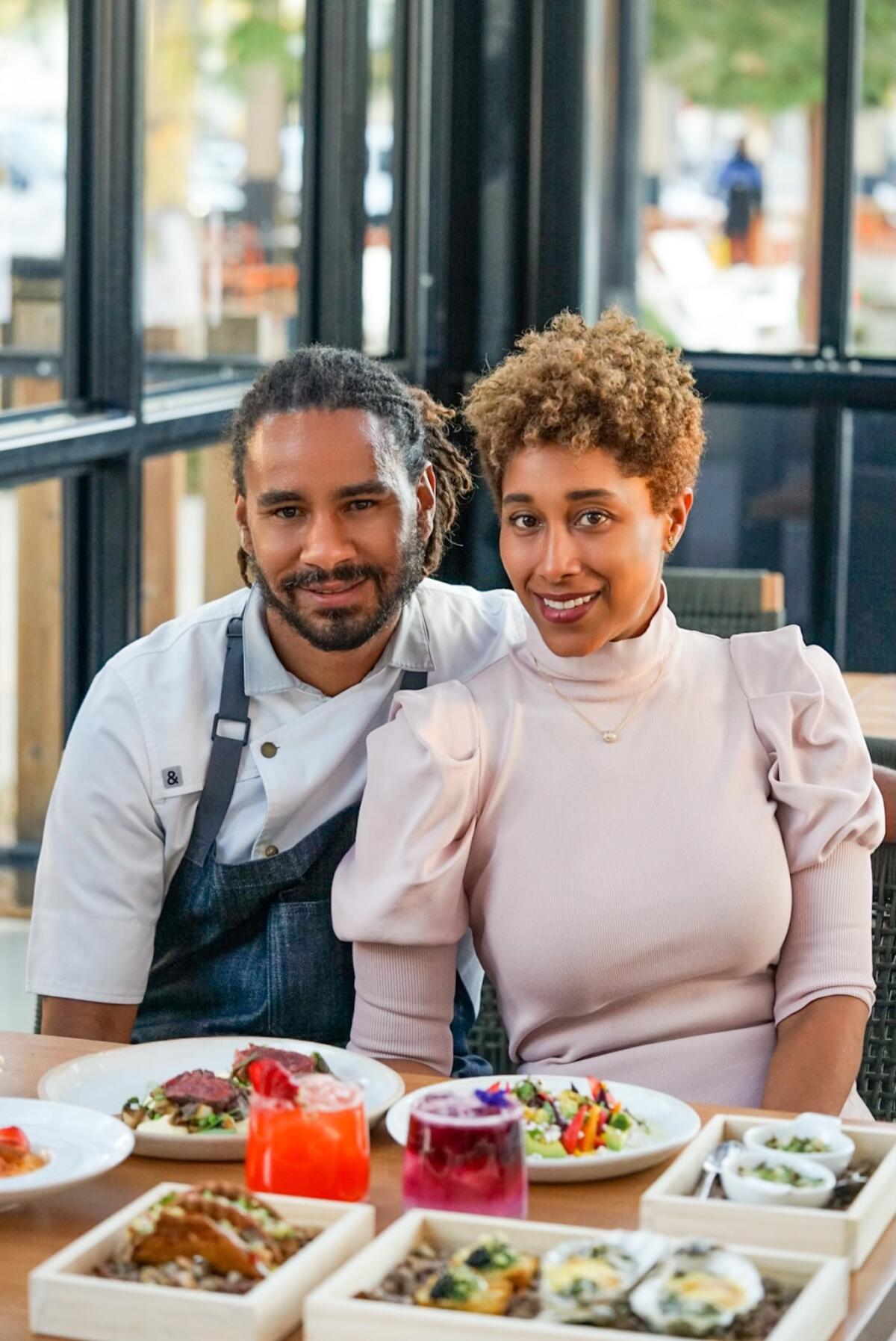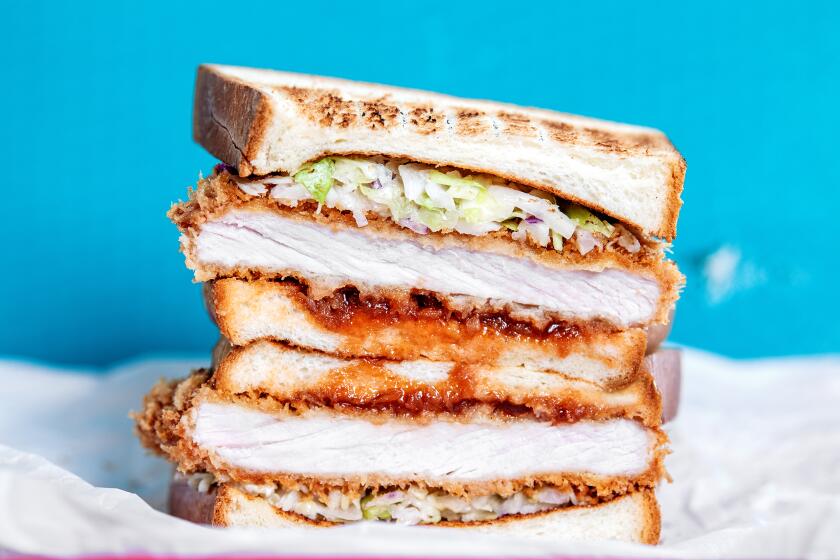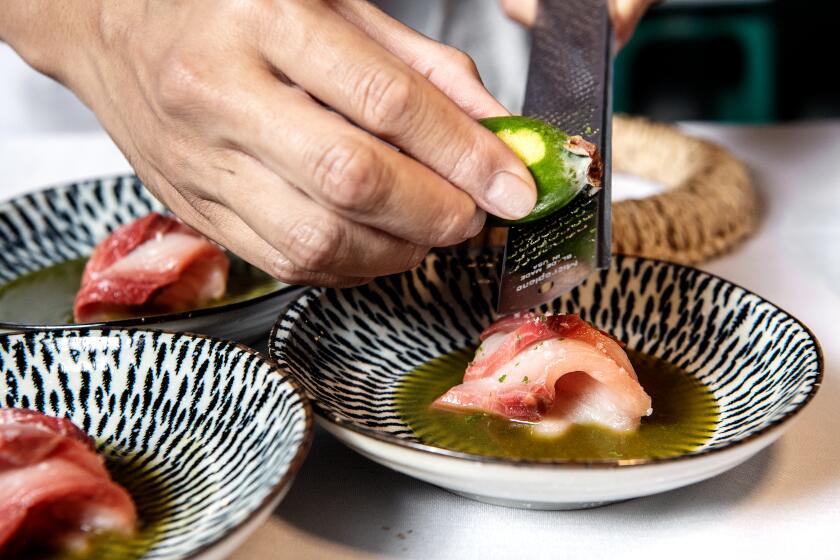‘Are you breathing? Hired.’ Why SoCal restaurants are still deeply short-staffed

- Share via
In the fall of 2021, assistant restaurant manager Jamie Wongaroon witnessed a disgruntled customer berating a host during a busy dinner service at Uzumaki, the small sushi restaurant she manages in Culver City. The next day, Wongaroon spent around $200 at Restaurant Depot to buy chalkboard signs before her shift. She placed one of the signs out front and wrote the following message to customers:
“Most of our staff are new, please be nice to them. Thank you for your patience.”
She signed the message with a happy face.
Wongaroon had been struggling to find staff for the restaurant for months. She cut lunch service because she didn’t have enough people to keep the restaurant open for two shifts, and four months had gone by without finding a single person for any of the multiple open positions for cooks and servers. The berated employee was the one person Wongaroon was able to hire and desperately needed to keep.
“I was afraid he would quit because he was too traumatized,” the manager said. “I thought I needed to write a sign so we didn’t keep having to explain to people that we were short-staffed and that things might take longer.”
From dumplings to burgers to tacos, here are the most affordable restaurants from our annual guide to the 101 Best Restaurants in L.A.
Uzumaki is just one of the thousands of restaurants still struggling to escape the sandpit created by the ongoing pandemic. A lack of adequate staffing has forced many to cut hours of operation and shrink menus. Workers are leaving the industry in search of higher pay and better hours. At a time when the minimum wage is set to increase in Los Angeles on July 1 to more than $16 an hour, restaurants are left in an ever-constricting bind: how to increase staff pay, keep up with ingredient costs and keep prices to a level customers can digest.
A January report from the National Restaurant Assn. showed that, as of December, nearly four in five restaurants around the country didn’t have enough employees to meet customer demand. In California, data from the U.S. Bureau of Labor Statistics shows the state had more than 102,500 fewer jobs in the food and beverage sector in February 2022 than it did in February 2020, or a 7% overall drop.
Sang Yoon, the chef-owner of the three Father’s Office restaurants and Lukshon, currently needs to hire about a dozen people for various positions, including line cooks, hosts, bartenders, dishwashers and prep cooks. Two of his restaurants went from being open seven days a week to just five when he reopened his dining rooms last year.

“People ask if we’re back to normal,” Yoon said. “No, and because it’s difficult to find staff, even though there is a demand, it’s going to take us longer. I know a lot of people who left the industry.”
One of Yoon’s former food runners and bussers became a baggage handler at LAX, then moved to Houston. Two cooks moved to Bakersfield and found jobs in farming. Another cook left for a mattress factory.
“I understand, and I don’t begrudge them,” Yoon said. “The restaurant industry became an undependable place to earn an income.”
Tony Esnault, chef at the Michelin-starred Knife Pleat at South Coast Plaza in Costa Mesa, has had trouble finding staff since reopening in the summer of 2020. The fine-dining restaurant requires a certain level of skill in the kitchen, which is set up with specific stations and jobs for each member of the team.
It’s been a challenge to fill all positions, but none has been more difficult than a dishwasher. The restaurant is still short two dishwashers, but Esnault and his wife and Knife Pleat co-owner, Yassmin Sarmadi, said they’re making it work any way they can.

“It used to be if you were a good restaurant with a good reputation and a good chef, you had staff,” Sarmadi said. “We’ve always been willing to train people to have somebody enjoy that level of rigor and detail and want to stay. That’s become a challenge.”
There was a point a few months ago when the kitchen was forced to function for weeks without a dishwasher. Esnault and his team of chefs took turns in the dish pit, washing pots and pans they had just used before returning to their kitchen stations. The managers and servers pitched in as well.
During the summer of 2021, Knife Pleat’s robust menu of a la carte items was slashed in half. The chefs and sous chefs were cooking instead of expediting. All of the sous chefs and managers became line cooks. Everyone cleaned their own dishes.
“With no staff, I can’t do the same thing we did before,” Esnault said. “It’s impossible.”
L.A. is home to a new kind of tasting menu: less pretentious, more casual, cuisines that span the globe and chefs hungry for innovation.
Sarmadi and Esnault paid for job postings on employment sites Craigslist and Indeed but to no avail. They used the restaurant’s social media handles to get the word out. Nothing was working. Pre-pandemic, Sarmadi said four out of 10 scheduled job interviews would be no-shows. During the last two years, that number rose to eight out of 10.
“Any recruitment became a complete joke,” she said. “We didn’t expect anyone to show up anymore, and if they did, we were caught off-guard.”
Restaurant owner Kwini Reed said that in the fall of 2021 she spent around $3,000 a month on job postings on Indeed for various positions at her and her husband, chef Michael Reed’s, two restaurants: Poppy + Rose in downtown L.A. and Poppy & Seed in Anaheim.
“Even if people don’t show up for their interview, I’m still being charged for the job postings,” Kwini Reed said. “It got to the point where I was like, ‘If you just walk through the door, I’m going to hire you. Are you breathing? You know how to say hello? Hired.’”
At Poppy & Seed, the Reeds opened the seasonal restaurant with the intent of changing the menu often. Instead, a lack of properly trained staff and high turnover have meant sticking to a menu the kitchen can handle.
“We slowed down menu changes because of the learning curve in the kitchen, and servers having to go sell the new items in front of the house stressed them out,” she said.
The extra pressure and hours required of the existing kitchen staff have taken a toll on the team and the payroll at Camphor, a new restaurant in the Arts District downtown. Owner Cyrus Batchan said that his two executive chefs, Max Boonthanakit and Lijo George, are routinely in the kitchen until 3 a.m. prepping food for the next day.
Some of the menu items, such as the chicken, are too advanced to leave to cooks without the proper training and experience. The butchering of the chicken requires a precise technique to remove the skin. If done incorrectly, vital ingredients are wasted. The two chefs are often breaking down 100 pounds of chicken after a full eight- to 10-hour shift.
“If it’s done incorrectly, the chefs will have to come in the next morning and do it all over again,” Batchan said. “And we’ll have wasted food too.”

The extra hours in the kitchen are adding up. While Batchan, a longtime restaurant owner who also runs Lock & Key in Koreatown, said he accounts for little to no profits in the first months or even year of a business, the extra costs associated with the lack of staffing and the ongoing pandemic are unprecedented.
Batchan is scheduling his team for eight- to nine-hour shifts, but his kitchen employees are routinely hitting 12 to 15 hours because the restaurant is short-staffed.
“People are also expecting to get paid more, so your wage burden on the business is significantly increased,” he said. “You’re better off hiring more staff versus hitting overtime, but if you can’t find staff, what do you do? Raise prices?”
One way Batchan is hoping to keep his staff happy is with a 20% service charge on all guest checks. The entirety of that charge goes to the staff.
“You’re just hoping the consumer has some understanding and that when they see prices increase a little, it’s not the restaurant owner trying to get one over on you,” he said.
Without the ability to pay her staff more, Kwini Reed said she’s focusing on internal marketing to her employees. Some employees would walk in, work for an hour and then walk out, telling her the restaurant down the street was willing to pay 50 cents more an hour.
“When you see In-N-Out Burger is hiring at $18 an hour to start, we can’t do that,” she said. “So we had to focus on employee retention and make them staying contingent on not just how much money they’re making but how we make them feel.”
The Reeds frequently check in with their employees to ask about their physical and mental well-being. In the kitchen, they are patient with new staff and invest in training. If someone is short on money, Kwini Reed tells them to come to her and “we’ll figure something out.”
She said the check-ins also have helped put the staff in the right mindset when customers, who aren’t always on their best behavior, give negative feedback.
If mom-and-pop eateries serving galbijim, kimchi jjigae or soondubu are replaced by trendy fusion places and chains, will Koreatown lose its soul?
“Customers have anxiety and anger, like we all do. They take it out on the servers because we are short-staffed, and the server is affected,” she said. “Customers don’t understand that we are short-staffed, and most don’t care. They want everything to be back to normal, but it’s not like turning on a switch.”

The sign out front at Uzumaki seems to be working, most of the time. And Wongaroon is relying on friends to fill in as part-time employees at the restaurant until she can find a full-time staff.
“When people are waiting for a table outside, we walk by and apologize, and people say they see the sign, so it really helps,” she said. “But not with everyone. Some people just don’t care.”
The customer, it seems, is not always right.
More to Read
Eat your way across L.A.
Get our weekly Tasting Notes newsletter for reviews, news and more.
You may occasionally receive promotional content from the Los Angeles Times.














